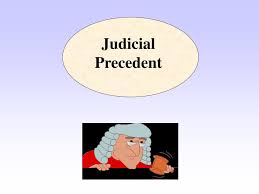Table of Contents
Precedent as a Source of Law
Precedent:
Introduction:
Judicial Precedent means the process whereby judges follow the decided cases. The doctrine of judicial precedent involves use of the doctrine of stare decisis, to stand by the decided. In practice, this means that lower courts are bound to apply the legal values set down by higher courts in earlier cases. This provides uniformity of law. This is known as the Judicial Precedent.
Precedent as a source of law:
Judicial Precedents are an important source of law. They have enjoyed high authority at all times and in all countries.
According to Salmond: “The great weightage of the unwritten law is almost entirely the product of outside cases, collected in an enormous series of reports extending backward, if it’s not in theory, the common law of England has been created by the decisions of English judges.”
According to Stobbe: “Training is in itself not a source of law, a court can depart from its official practice and no court is bound to practice another. Departure from the practice hereby is observed and not only permitted but required if there are better reasons for the questions of law.”
Blackstone writes: “For it is an established rule to respect the former precedents, where the same points come again in litigation, as to keep the rule of justice even and different and not liable to with every judge’s opinion, as also because the law, in that case, being perfectly declared, what before was uncertain has now become the permanent rule, subsequent judge to alter according to private opinions.
Kinds of Precedent
- Authoritative and Persuasive Precedent– According to Salmond, an authoritative precedent is one which judges must follow whether they agree to it or not. A persuasive precedent is one which the judges are under no duty to follow but to which they will take into consideration and to which they will attach great weight as it seems to them to deserve.
- Absolute and Conditional Precedent– Authoritative precedents are of two kinds, absolute and conditional. In the case of absolute precedents, they have to be surveyed by the judges even if they do not accept it. They are entitled to implied obedience. A conditional precedent can be accepted by overruling. In the case of overruling, the precedent overruled is authoritatively pronounced to be wrong so that it cannot be followed by the courts in the future.
- Declaratory and Original Precedents– A declaratory precedent is one which is merely the request of an already existing rule of law. An original precedent is one that makes and establishes the new rule. These are called original precedents.
Conditions destroying or weakening the binding force of Precedent:
There are circumstances that destroy or weaken the binding force of a precedent. Those are exceptions to the rule of the binding force of precedent
- Abrogated Decision– A decision terminates to be binding if a statute is varying with it is subsequently enacted, or if it is overruled by a higher court. A reversal occurs when the same decision is taken on appeal and is reversed by the Supreme court. Overruling occurs when the higher court declared in another case that the precedent case was not correctly decided and so is not to be followed.
- Ignorance of Statute– A precedent is not binding if it was to be in ignorance of a statute or a rule having the force of a statute, i.e., delegated legislation. Even a lower court may refuse to follow a precedent on this ground.
- Inconsistency with Earlier Decisions of Higher Court– Precedent loses its binding force if the court that decided it overlooked a varying decision of the higher court. Thus, if the High Court of Delhi decides a case in ignorance of a decision of the High Court of Delhi is not binding on any lower court.
- Decisions of equally divided courts– Where an Appellate Court is equally divided, the practice is to dismiss the appeal. The rule adopted in the House of Lords is that the decision appealed becomes the decision of the House of Lords.
- Erroneous Decisions– Decisions may also be erred by being founded on wrong principles by conflicting with fundamental principles of the common law. Logic suggests that the court should be free to disregard those decisions. In Scruttons Ltd v. Midland Silicones Ltd, the House of Lords by a majority of four to one disregarded their own previous decision.
Ratio Decidendi:
According to Salmond: “A precedent is a judicial decision which contains in itself a rule. The underlying principle which thus forms its firm element is often termed the ratio decidendi. The concrete decision is binding to the parties to it but it is the feature ratio decidendi which alone has the force of law as regards and is binding in nature.”
Rupert Cross says that a ratio decidendi is a rule of law expressly or impliedly treated by the judge as a necessary step in reaching his decision.
According to M.R. Cohen: “You cannot take decisions from past to future without making assumptions. From the statement that the court has ruled so and so in certain cases, nothing follows except as the new cases are assumed to be old cases.
Obiter Dicta:
All that is said by the court by the way of the statements of law which go beyond the requirements of the particular case and which law lays down a rule that is irrelevant or unnecessary for the purpose in hand are called obiter dicta. These dicta have the force of persuasive precedents only. Obiter dicta help in the growth of law. These sometimes help the cause of the reform of law and development.
Dr. Goodhart defines obiter dicta as, “an end based on a fact and the existence of which has not been single-minded by the court.”
Author: Shreya Potdar,
S.N.D.T LAW COLLEGE

